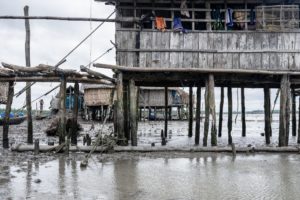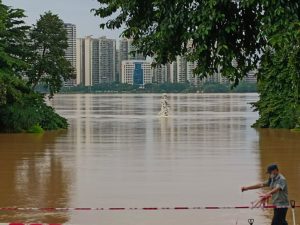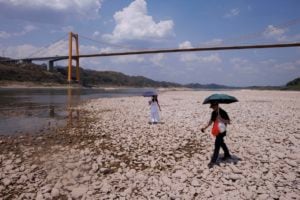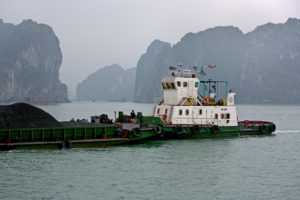Progress in adapting to climate change is still far too slow and lacks the finance needed to keep up with the accelerating impacts, according to an analysis by the United Nations Environment Programme (UNEP).
Published just ahead of the UN COP27 climate change talks in Sharm-el Sheikh, UNEP’s annual report on government action to boost resilience to increased heatwaves, droughts, floods and storms finds that more than 84% of countries have at least one strategy, law or policy related to adaptation – an increase of 5% from last year. Those that do not include Bolivia, Venezuela, Saudi Arabia and Iran.
Adaptation plans are improving overall and are more inclusive in considering gender and disadvantaged groups, such as indigenous peoples. The proportion of plans with quantified targets that have deadlines has increased, with one-third now including these. Projects implemented so far are focused on agriculture, water and ecosystems and primarily address the variability of rainfall, drought and flooding.
Although the report notes greater action on the ground, it warns that there is “no sign” of the acceleration needed to keep up with climate impacts, which risk outstripping support.
Many project types could both cut emissions and reduce the impacts of extreme weather, such as planting and conserving mangroves, restoring salt marshes or protecting peatlands, which can effectively remove carbon from the atmosphere and reduce flood risks. However, opportunities for such projects are frequently missed, with adaptation and mitigation measures often implemented independently, UNEP’s assessment finds.
Early warning needed
There are 400 medium to major disasters occurring annually, projected to rise to 560 by 2030 on current trajectories, warned the UN’s Office for Disaster Risk Reduction (UNDDR) in a report earlier this year.
“That means 1.5 medium to major disasters per day globally. This is a terrible forecast, but I’m afraid that is what the data tells us,” says Mami Mizutori, head of the UNDDR. She adds that governments need to tackle risk management comprehensively by bringing together climate adaptation and disaster risk reduction plans, which sometimes do not take future climate risks into account.
The UN advocates the development of early warning systems to reduce climate-related risk. Existing systems have been effective, such as in Bangladesh, where early cyclone warnings have saved thousands of lives, according to Henry Neufeldt, chief scientific editor of UNEP’s report.
“Impacts can be reduced significantly through the right actions. More countries now need to address and develop their national adaptation plans in order to have these responses ready,” he says.
Finance not flowing
Finance is a significant barrier. Though the flow of international finance to pay for adaptation in developing countries reached US$29 billion in 2020 – an increase of 4% from 2019 and a 34% share of overall climate finance – it is still five to ten times below the estimated need, and the gap continues to widen, UNEP warns. It estimates that the finance needed is $160-340 billion annually by 2030 and $315-565 billion by 2050.
UNEP Executive Director Inger Andersen says COP27 needs to see money put on the table to support adaptation for the poorest. She notes that after September’s Hurricane Ian, Florida’s Senator Marco Rubio asked for $35 billion in emergency support.
“This is one US state. So when we think that only $29 billion has gone into adaptation investments a year – it’s just so wholly inadequate,” she says.
Climate justice campaigners and developing countries have been calling for adaptation finance to double from 2019 levels by 2025. Governments committed to doing so in the outcome of last year’s COP26 climate talks, the Glasgow Climate Pact.
Red tape
The amount pledged by the richest to the poorest equates to as little as $11 per person per year in the least-developed countries, according to the International Institute for Environment and Development (IIED), a thinktank. But in addition to the quantity of finance, there are also issues with accessing it, with “onerous systems and red tape” making it completely inaccessible to the least developed countries, it adds.
Clare Shakya, director of IIED’s climate change research group, explains that it could take more than four years to get even a relatively small and short-term project agreed upon. She says that countries have to wait many weeks to even get feedback on an application, with multiple iterations of comments in any application process.
“A country has to prove their ministry is a legal entity, registered or set up under an act. It has to demonstrate not just that it has the required policies, but that it can also show it has a track record of using them. For example, it can’t just have an anti-corruption policy, but must have applied it in a specific case that has been fully pursued,” she says.
The investment pipeline is blocked; we must unblock it nowAntonio Guterres, UN secretary general
There is also a mismatch between what governments propose and what financiers consider investable, according to UN Secretary General Antonio Guterres.
“The world urgently needs a new business model for turning adaptation priorities into investable projects,” he says. “The investment pipeline is blocked; we must unblock it now. We need a global surge in adaptation investment to save millions of lives from climate carnage. It is high time for unprecedented coordination among recipient governments, development partners and other financiers.”
Seeking acceleration
Guterres has commissioned organisations, including the UN Development Programme and the Green Climate Fund, to work with public and private financiers and targeted countries to pilot a new Adaptation Pipeline Accelerator, which will report on its initial work during COP27.
Shakya says the initiative is a “valid effort” to tackle the barriers countries face in getting projects financed and developed, but it needs a deliberate effort to learn from other initiatives to be most effective.
She cites an accelerator programme for national emissions reduction plans (known as nationally determined contributions or NDCs) as an innovation that could provide useful experience. The programme brought private investors into workshops with governments to develop portfolios of projects they would be prepared to support, she says.
Andersen says there is also a role for the private sector to invest in resilience, noting small-scale examples are already happening, such as investments by the tourism sector in coastal restoration to protect infrastructure.
However, she says that governments need to assess where the highest exposure is so that the private sector can be directed to make the most effective investments. “Many argue that insurance schemes will be the way to go, and for a while, they will. But if we do not bring down temperature rise, the reality is that premiums will go up so high that no one will be able to afford insurance,” she said.
The report stresses that governments should not sideline climate adaptation due to other global issues, such as the war in Ukraine, global supply chain shortages and the Covid-19 pandemic.
“Climate adaptation may not seem like a priority right now. But it is. Even if all emissions reduction commitments are implemented immediately, the reality is that climate change is going to be with us for decades into the future, and the poorest will keep paying the price for our inaction,” Andersen says.









